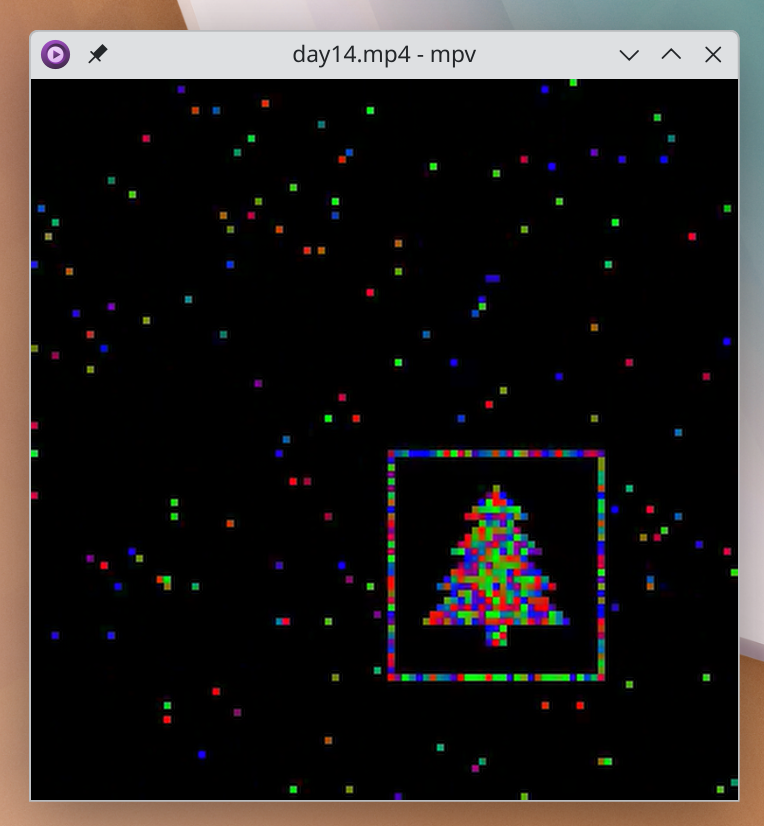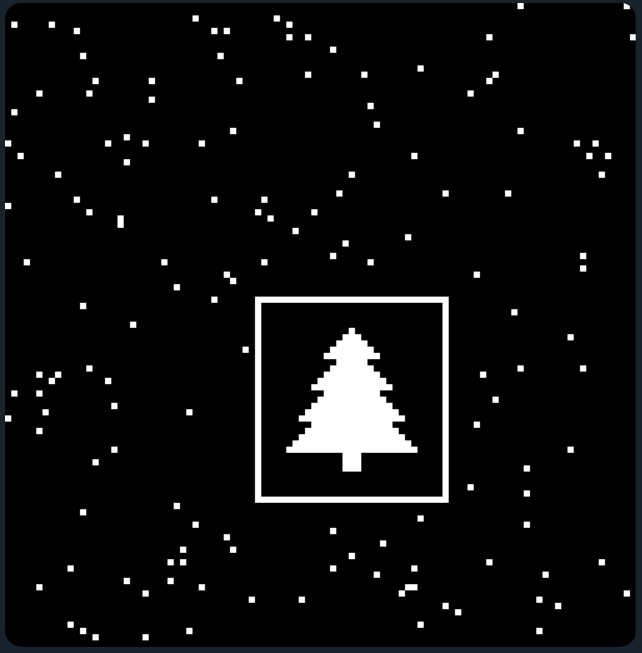TypeScript
Part 2 was a major curveball for sure. I was expecting something like the grid size and number of seconds multiplying by a large amount to make iterative solutions unfeasible.
First I was baffled how we're supposed to know what shape we're looking for exactly. I just started printing out cases where many robots were next to each other and checked them by hand and eventually found it. For my input the correct picture looked like this:
The Christmas tree

Later it turned out that a much simpler way is to just check for the first time none of the robots are overlapping each other. I cannot say for sure if this works for every input, but I suspect the inputs are generated in such a way that this approach always works.
The code
import fs from "fs";
type Coord = {x: number, y: number};
type Robot = {start: Coord, velocity: Coord};
const SIZE: Coord = {x: 101, y: 103};
const input: Robot[] = fs.readFileSync("./14/input.txt", "utf-8")
.split(/[\r\n]+/)
.map(row => /p=(-?\d+),(-?\d+)\sv=(-?\d+),(-?\d+)/.exec(row))
.filter(matcher => matcher != null)
.map(matcher => {
return {
start: {x: parseInt(matcher[1]), y: parseInt(matcher[2])},
velocity: {x: parseInt(matcher[3]), y: parseInt(matcher[4])}
};
});
console.info("Part 1: " + safetyFactor(input.map(robot => calculatePosition(robot, SIZE, 100)), SIZE));
// Part 2
// Turns out the Christmas tree is arranged the first time none of the robots are overlapping
for (let i = 101; true; i++) {
const positions = input.map(robot => calculatePosition(robot, SIZE, i));
if (positions.every((position, index, arr) => arr.findIndex(pos => pos.x === position.x && pos.y === position.y) === index)) {
console.info("Part 2: " + i);
break;
}
}
function calculatePosition(robot: Robot, size: Coord, seconds: number): Coord {
return {
x: ((robot.start.x + robot.velocity.x * seconds) % size.x + size.x) % size.x,
y: ((robot.start.y + robot.velocity.y * seconds) % size.y + size.y) % size.y
};
}
function safetyFactor(positions: Coord[], size: Coord): number {
const midX = Math.floor(size.x / 2);
const midY = Math.floor(size.y / 2);
let quadrant0 = 0; // Top-left
let quadrant1 = 0; // Top-right
let quadrant2 = 0; // Bottom-left
let quadrant3 = 0; // Bottom-right
for (const {x,y} of positions) {
if (x === midX || y === midY) { continue; }
if (x < midX && y < midY) { quadrant0++; }
else if (x > midX && y < midY) { quadrant1++; }
else if (x < midX && y > midY) { quadrant2++; }
else if (x > midX && y > midY) { quadrant3++; }
}
return quadrant0 * quadrant1 * quadrant2 * quadrant3;
}

